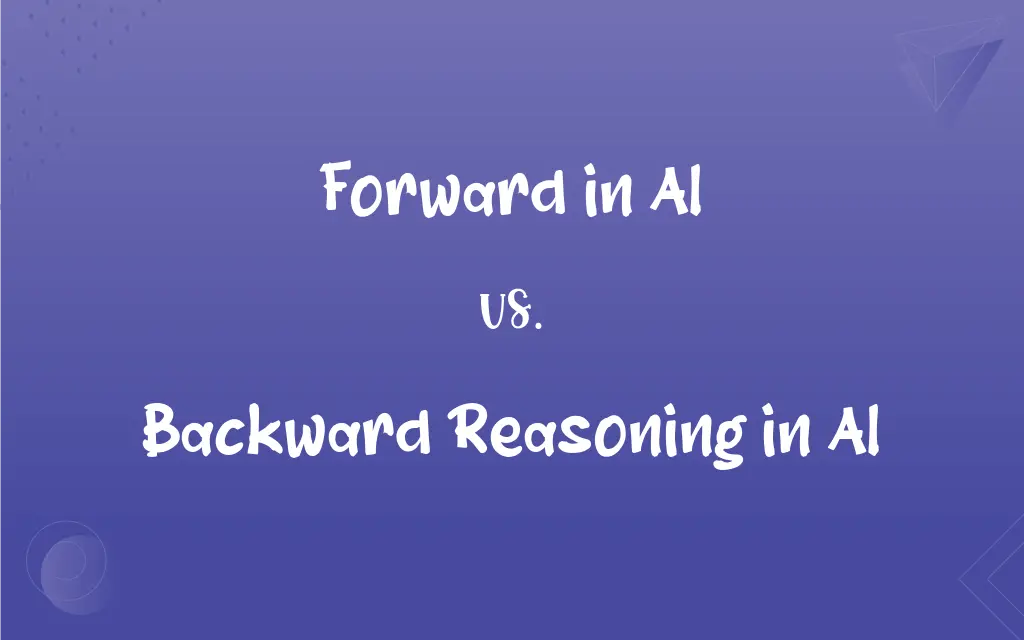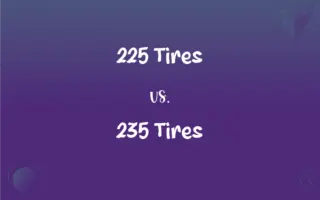Forward in AI vs. Backward Reasoning in AI: What's the Difference?
Edited by Aimie Carlson || By Janet White || Published on February 16, 2024
Forward reasoning in AI starts with known facts and applies rules to infer new facts; backward reasoning begins with a goal and works backwards to find supporting facts.

Key Differences
Forward reasoning, also known as forward chaining, in AI, begins with the available data or known facts and applies inference rules to derive new facts or conclusions. Backward reasoning, or backward chaining, conversely, starts with a goal or hypothesis and works backward to deduce the necessary conditions or facts that support this goal.
In forward reasoning, the process moves from the general to the specific, making it effective in scenarios where all potential outcomes need to be explored. Backward reasoning, moving from specific to general, is more efficient in situations where there is a specific target or outcome to be achieved, as it narrows down the focus to relevant facts only.
Forward reasoning is often used in expert systems for diagnostic purposes, like medical diagnosis, where all symptoms are considered to reach a conclusion. Backward reasoning is more common in systems like interactive troubleshooting guides, where the system starts with a specific problem and works backward to find the cause.
The choice between forward and backward reasoning in AI depends on the nature of the problem, the structure of the knowledge base, and the desired outcome. Forward reasoning can lead to the discovery of unexpected insights by exploring all possibilities, while backward reasoning is more goal-directed and can be more efficient in reaching a specific conclusion.
Forward reasoning continuously applies rules until no more new information can be inferred, while backward reasoning stops as soon as it finds a path that connects the goal with the available facts. This makes forward reasoning potentially more exhaustive but also resource-intensive compared to the more focused approach of backward reasoning.
ADVERTISEMENT
Comparison Chart
Starting Point
Known facts or data
A specific goal or conclusion
Direction of Reasoning
From general to specific (data-driven)
From specific to general (goal-driven)
Common Use Cases
Diagnostic systems, exploring all possibilities
Troubleshooting, focusing on a specific problem
Efficiency
Explores all outcomes, can be resource-intensive
More targeted, efficient for specific goals
Approach
Applies rules to derive new facts
Works backward to find supporting facts
ADVERTISEMENT
Forward in AI and Backward Reasoning in AI Definitions
Forward in AI
Applies rules to known facts to infer new information.
Using forward reasoning, the AI system deduced potential health risks from patient symptoms.
Backward Reasoning in AI
Efficient for problems with specific targets.
Backward reasoning efficiently diagnosed the issue in the complex machinery.
Forward in AI
Explores all possible outcomes from given facts.
Forward reasoning in the AI model generated multiple scenarios for climate change predictions.
Backward Reasoning in AI
Starts with a goal and works backward to find facts.
To solve the puzzle, the AI used backward reasoning from the desired outcome.
Forward in AI
Moves from general data to specific conclusions.
The robot used forward reasoning to navigate the environment based on sensor input.
Backward Reasoning in AI
Moves from specific conclusions to general facts.
The legal AI applied backward reasoning to find precedents for the case.
Forward in AI
Common in expert systems for diagnostic analysis.
In financial analysis, forward reasoning helps identify investment opportunities.
Backward Reasoning in AI
Stops when it connects the goal with known facts.
Using backward reasoning, the AI determined the root cause of the network failure.
Forward in AI
Continuously applies inference rules.
The AI used forward reasoning to update its knowledge base with new scientific data.
Backward Reasoning in AI
Focused and goal-oriented reasoning approach.
Backward reasoning led the AI to identify the key factors for the business strategy.
FAQs
When is forward reasoning used?
In scenarios requiring exploration of all possible outcomes from known data.
What is backward reasoning in AI?
It's starting with a goal and finding supporting facts to reach that goal.
What is forward reasoning in AI?
It's inferring new facts from known data using inference rules.
How does forward reasoning differ in approach?
It moves from general data to specific conclusions.
Can forward reasoning lead to unexpected insights?
Yes, by exploring all possibilities.
How does backward reasoning aid in problem-solving?
By focusing on the goal and identifying necessary conditions to achieve it.
What is an example of backward reasoning in AI?
Troubleshooting systems that identify causes for specific problems.
What type of problems is backward reasoning best suited for?
Problems with a specific target or goal.
Is backward reasoning more efficient than forward reasoning?
It can be more efficient in reaching specific goals.
What is a common application of forward reasoning?
Diagnostic systems in medicine or finance.
Does forward reasoning require a goal?
No, it works with available data to infer new information.
What stops the backward reasoning process?
Finding a path that connects the goal with known facts.
Is backward reasoning useful in legal AI applications?
Yes, for finding relevant precedents or facts for a case.
Which is more resource-intensive, forward or backward reasoning?
Forward reasoning, as it explores all possibilities.
How does forward reasoning handle new information?
It continuously applies rules to integrate new facts.
What is the end point of forward reasoning?
When no more new facts can be inferred.
Can both reasoning types be used in the same AI system?
Yes, they can complement each other depending on the problem at hand.
What makes backward reasoning goal-driven?
It starts with the desired outcome and works backward.
Can backward reasoning be used for diagnostics?
Yes, especially when diagnosing specific issues.
How do expert systems utilize forward reasoning?
To analyze and draw conclusions from existing data.
About Author
Written by
Janet WhiteJanet White has been an esteemed writer and blogger for Difference Wiki. Holding a Master's degree in Science and Medical Journalism from the prestigious Boston University, she has consistently demonstrated her expertise and passion for her field. When she's not immersed in her work, Janet relishes her time exercising, delving into a good book, and cherishing moments with friends and family.
Edited by
Aimie CarlsonAimie Carlson, holding a master's degree in English literature, is a fervent English language enthusiast. She lends her writing talents to Difference Wiki, a prominent website that specializes in comparisons, offering readers insightful analyses that both captivate and inform.































































